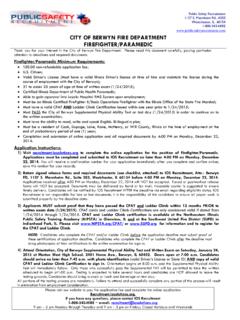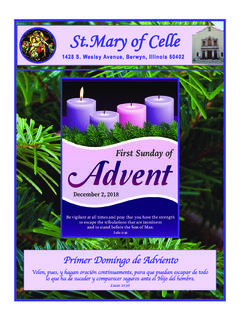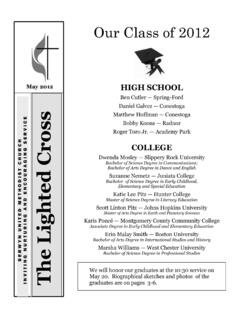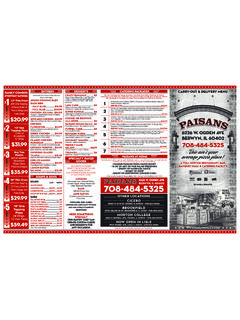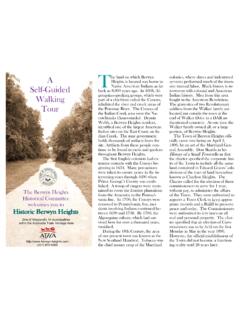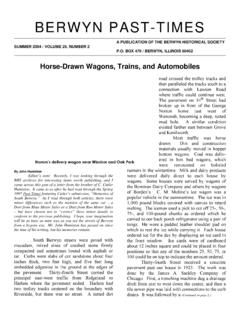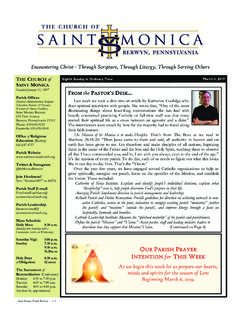Transcription of Bordering the Mainstream - Rob Paral
1 Borderingthe Mainstream :A Needs Assessment of Latinos in berwyn and Cicero, IllinoisJanuary 2002 Bordering the MainstreamA Needs Assessment of Latinos inBerwyn and Cicero, IllinoisJanuary 2002 Produced by the Institute for Latino Studies Communications GroupDesign: Jane A. Norton, Creative SolutionsDocumentary Photography: Alan Pogue 2002 University of Notre DameTable of ContentsIntroduction ..vAcknowledgements ..viiWho Are the Latinos of berwyn and Cicero? ..1 Diverse National Origins ..1 Residential Patterns ..2 What Does Latino Mean? ..4 berwyn -Cicero Latinos Have Roots in Chicago and Abroad ..5 Mexico ..6 Mexican Population Growth in the Twentieth Century ..7 Mexican Immigrants and Their Reception ..8 Public Policies Particularly Relevant to Latinos.
2 10 Latino Population Growth in berwyn and Cicero ..13 Latino Social and Economic Status ..15 Latino Families ..25 Latino Strengths ..29 The berwyn -Cicero Environment for Latinos ..31 History of Cicero ..31 Cicero Corruption History ..34 History of berwyn ..36Do Latinos Feel Accepted in Cicero? ..37Do Latinos Feel Accepted in berwyn ? ..38 Issue-by-Issue Analysis of Local Needs ..39 Children, Youth, and Education ..42 Political and Community Representation and Participation ..51 Law Enforcement, Crime and Violence ..57 Health ..60 Immigration ..65 Housing ..67 Social and Human Services ..71 Employment/Occupation ..73 Local Businesses ..77 Transportation ..80 Discussion of Community Priorities ..82 Conclusion ..85 Overall Goal ..85 Three Key Objectives.
3 85 Methodology ..87 End Notes ..95iiiPercentage of personsof Latino origin(any race), CountyPercentage of Persons of Latino Origin, 2000 IntroductionThe City of berwyn and the Town of Cicero, Illinois, are suburbs locatedwest of Chicago. Cicero borders the City of Chicago and has been calledthe First Suburb West because it was the first suburb to grow up west ofChicago. berwyn is located immediately west of Cicero and shares a three-mile border with its berwyn and Cicero were established in the nineteenth century,but their populations boomed in the early decades of the twentiethcentury. Both have had distinctive ethnic communities, which until recentdecades consisted primarily of first-, second-, and third-generation Easternand Southern Europeans, particularly persons of Polish, Czech,Lithuanian, and Italian the twentieth century Cicero developed a national reputation thathad various facets.
4 The town was remarkable for extraordinary industrialdevelopment but also for political corruption and racial s reputation has been arguably more positive. It is a city of homesrather than industry, and the classic image of berwyn for local residents is the tree-lined street of tidy brick bungalows. Profound economic changes arrived in berwyn and Cicero in the latterdecades of the twentieth century, as they did in many corners of theindustrial Midwest. Factories closed, threatening the sustainability of taxrevenues and leaving many residents without their traditional than a few residents left the area for other suburbs or for newfutures in the southern and western states of the United States. The Whiteethnic population that remained grew older. The typical number ofpersons in a household shrank, and fewer children were to be seen on thestreets and in the schools.
5 By the 1980s berwyn and Cicero had some ofthe oldest populations in the metropolitan the 1980s and with even greater speed in the 1990s, however, a newcommunity began to move into berwyn and Cicero in large , most of them of Mexican ancestry, began to purchase the homes,establish the retail businesses, and send their children to the schools of thetwo suburbs. By 2000 Cicero had become 77 percent Latino thoughLatinos had been merely 9 percent of the population only twenty yearsearlier and berwyn is now 38 percent Latino. INTRODUCTIONvThis extraordinary demographic upheaval meant that berwyn andCicero were redefining themselves. Some aspects of their traditions andhistory such as industrial employment and European heritage were lost,but a vital and energetic new group, often consisting of immigrants, came to offer its contributions to the date little research has been done on the meaning of Latinopopulation growth for berwyn and Cicero.
6 How are the communitieschanging? What are the needs of Latinos? What are their contributions?How has the larger community accepted the newcomers? Where areBerwyn and Cicero going? Clearly, community leaders, public policymakers, social service providers, and others in the local area will benefitfrom having a greater understanding of the Latino community scharacteristics and the state of the berwyn and Cicero communities into which Latinos are moving in such impressive numbers. Assessing Latino Needs and Assets in berwyn and CiceroThis report is an assessment of the needs and assets of the Latinocommunities in berwyn and Cicero. A report of this type seeks to describean area s social, economic, and other needs that, if addressed, will lead to a better quality of life for community residents.
7 This report also describesthe Latino community s assets that can facilitate an improved quality of life and that should be taken into consideration by governmental,philanthropic, and other actors seeking to effect change. This needs and assets assessment is based in part on interviews andfocus groups through which we spoke with 172 members of the Berwynand Cicero communities in the spring and summer of 2001. We haveincluded numerous quotations from those interviewees. We also presentdemographic, socioeconomic, and other data from a variety of sources and survey data obtained from our interviews with community report begins with an overall characterization of the Latinos of berwyn -Cicero, selected demographics, and a brief history of the two communities from their nineteenth-century roots to the present.
8 For a description and analysis of the fieldwork data, go to page 39. The methodology of the study is explained on pages 87 MacNeal Health FoundationOne of the oldest institutions in all of berwyn and Cicero is the MacNealHospital, founded at the beginning of the last century by Dr. ArthurMacNeal. Untold thousands of area residents have been born at MacNealand/or provided with lifetime medical care by the hospital. In 1999 Vanguard Health Systems, Inc., of Nashville purchased the MacNealMemorial Hospital. The transaction provided the opportunity to create a philanthropic foundation using a portion of the proceeds of the sale, and thus the MacNeal Health Foundation was incorporated in October1999. Through its grant-making the Foundation continues the old MacNeal Hospital s legacy of service to the community by seeking tomake a positive impact upon the health-related and educational needs ofyouths, adolescents, seniors, and the community at large in the berwyn -Cicero Dame s Institute for Latino Studies and the berwyn -CiceroLatino Community InitiativeThe Institute for Latino Studies (ILS) at the University of Notre Damepromotes understanding and appreciation of the Latino experience in theUnited States through education, research, and outreach.
9 The Institute iscommitted to research projects that are both academic and policy-relevantand include a significant component of service to local Latino June 2000 the MacNeal Health Foundation selected the Institutefor Latino Studies to carry out the berwyn -Cicero Latino CommunityInitiative. The Initiative has two major research components, includingthe present needs and assets assessment and an upcoming longitudinalsurvey of community opinion and experience whose design will be based,in part, on the findings of the present report. The Initiative also includesservice learning projects in which university students work with localcommunity organizations and churches and ongoing identification ofopportunities to promote local leadership development and training.
10 Staff of ILS who are affiliated with this research report include ChristopherAhn, Mar a Elena Bessignano, Allert Brown-Gort, Miryam Bujanda,Gilberto C rdenas, Priscilla Clements, Sung Chun, Caroline Domingo,ACKNOWLEDGEMENTSviiPhilip Garc a, Rosa Garc a, Kate Huetteman, Robyn Mann, Sylvia Puente,Zo Samora, Wei Sun, and Betsy Puente of the Institute for Latino Studies serves as Project Directorof the berwyn -Cicero Latino Community Initiative. She has had primaryoversight responsibilities for nearly all aspects of the present assessment ofLatino needs and Partners: DePaul University and the Interfaith LeadershipDevelopment Project of Cicero, berwyn , and StickneyFor the present needs and assets evaluation the Institute for Latino Studiesis working in partnership with the Egan Urban Center and the Center for Latino Research of DePaul University and the Interfaith LeadershipProject of Cicero, berwyn , and Stickney.
